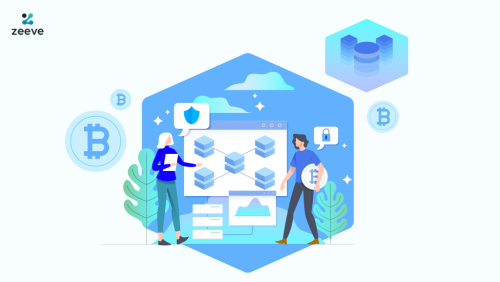Gain a Better Grip on Blockchain
By: Mike Talbot, president of the Overland Park, Kan. GBA, and vice president and chief technology officer at Veracity Consulting
Bitcoin was born like a shot into the wild, wild west of the “next Internet.” Yet, even after all we’ve learned since its inception, we’re still taming the landscape of the latest blockchain developments. Needless to say, this tech is still widely misunderstood. (But that doesn’t make it any less exciting.)
Many people I speak with make the mistake of assuming blockchain and Bitcoin are one in the same. While related, however, they’re not synonymous. Look at it this way: If blockchain were an interstate highway, Bitcoin would be one of the cars on that highway (a fancy golden one, of course). Bitcoin is a type of cryptocurrency made possible by blockchain technology.
Blockchain itself is actually fairly simple when you dig down. It was originally conceived in 1991 as a way to digitally timestamp documents to prevent anyone from backdating or tampering with them. But the concept was mostly unused until Bitcoin was introduced in 2009.
It’s essentially a decentralized technology that uses vast peer-to-peer networks of so-called computing “nodes” that make up a chain. Each node or “block” in the chain contains a piece of data being transmitted, as well as a unique identifier of that block (a kind of “fingerprint”) and the identifier of the previous block in the chain.

OVERVIEW OF THE BLOCKCHAIN PROCESS.
You can think of it as a distributed database or a shared digital ledger, which builds an ever-growing list of records (blocks) in the order in which they were created. The data inside the blocks depends on the type of blockchain. Bitcoin blocks, for example, contain all the transaction details, like the amount of coin, the sender, receiver, etc.
When one party wants to send data to another party, identical copies of the transaction are shared to every member of the network. This shared database can be used to make transactions, create records, timestamp documents, etc. And because this ledger is stored on each node of the network – and the network reconciles each transaction every 10 minutes – no one user can corrupt the data. This provides a new level of both transparency and security.
Of course, as McKinsey reports, we’re still learning just how far it can go:
“Blockchain technology could provide the infrastructure for sophisticated networks that manage payments, sales, trading and distribution. Given their potential to streamline transactions and cut costs, blockchains and smart contracts could help to remove pain points and friction throughout the power value chain. That said, blockchain technologies are still in their infancy, and questions remain about security, scalability and governance.”
WIDENING THE BLOCKCHAIN NET
While I would argue blockchain is not the right fit for every industry, it’s already showing promise in several. And it’s not just companies either; many government agencies are hopping on board:
- The U.S. Federal Reserve is looking at blockchain for its monetary transactions.
- The Indian government announced interest in using blockchain to reduce financial fraud.
- The United Nations is interested in blockchain for humanitarian causes to help bring identity to people.
- The state of Illinois is working to move its entire citizen identification system (birth registry, driver licenses, etc.) to blockchain.
Because Veracity serves both commercial and government clients, we see potential in blockchain for many types of projects, especially those that include:
- Large database technology
- Distributed accounting ledgers that use software to track every detail of a transaction
- Cryptography to protect digital transactions against hacking
- High-speed Internet networking and connectivity to virtually any device
- Internet of Things (IoT) projects where almost any device can be network addressable and enabled (machines talking directly to other machines)
- Mobility of data, digital applications and convenience of computing
- Open systems that rely upon transparency and collaboration
As if those areas weren’t enough, blockchain is also being evaluated for use in notary, digital assets, global supply chains, smart contracts, online voting, and many more.
JOINING THE TECH EVOLUTION
For those of us in the industry, it’s thrilling to watch how all of this unfolds. Blockchain is growing at a staggering rate, and nearly every major industry is already using it in some way or another. We’re seeing a lot of companies dip a toe in the water to solve specific industry problems and set up their own processes—very similar to what we saw as the World Wide Web was emerging from its own wild west, when business testing occurred on an LAN before making the leap to the public Internet.
Exciting times, indeed, but really just the next evolution of technology. Karim Lakhani, professor of business administration at the Harvard Business School and co-author of The Truth About Blockchain, elaborates in Computer World:
“Conceptionally, this is TCP/IP applied to the world of business and transactions. In the ‘70s and ‘80s, TCP/IP was not imaginable to be as robust and scalable as it was. Now, we know that TCP/IP allows us all this modern functionality that we take for granted on the web. Blockchain has the same potential.”
If you’re ready to learn more about blockchain and the possible implications to your business processes, we’re ready to help your business be in a stronger position when the dust settles on this new tech civilization.
Mike Talbot is vice president and chief technology officer at Veracity Consulting, a tech consulting team of problem-solvers and truth-tellers who deliver customized IT solutions for commercial and government clients across the U.S. Learn more at engageveracity.com, and share your thoughts on Facebook or Twitter @engageveracity.





Responses